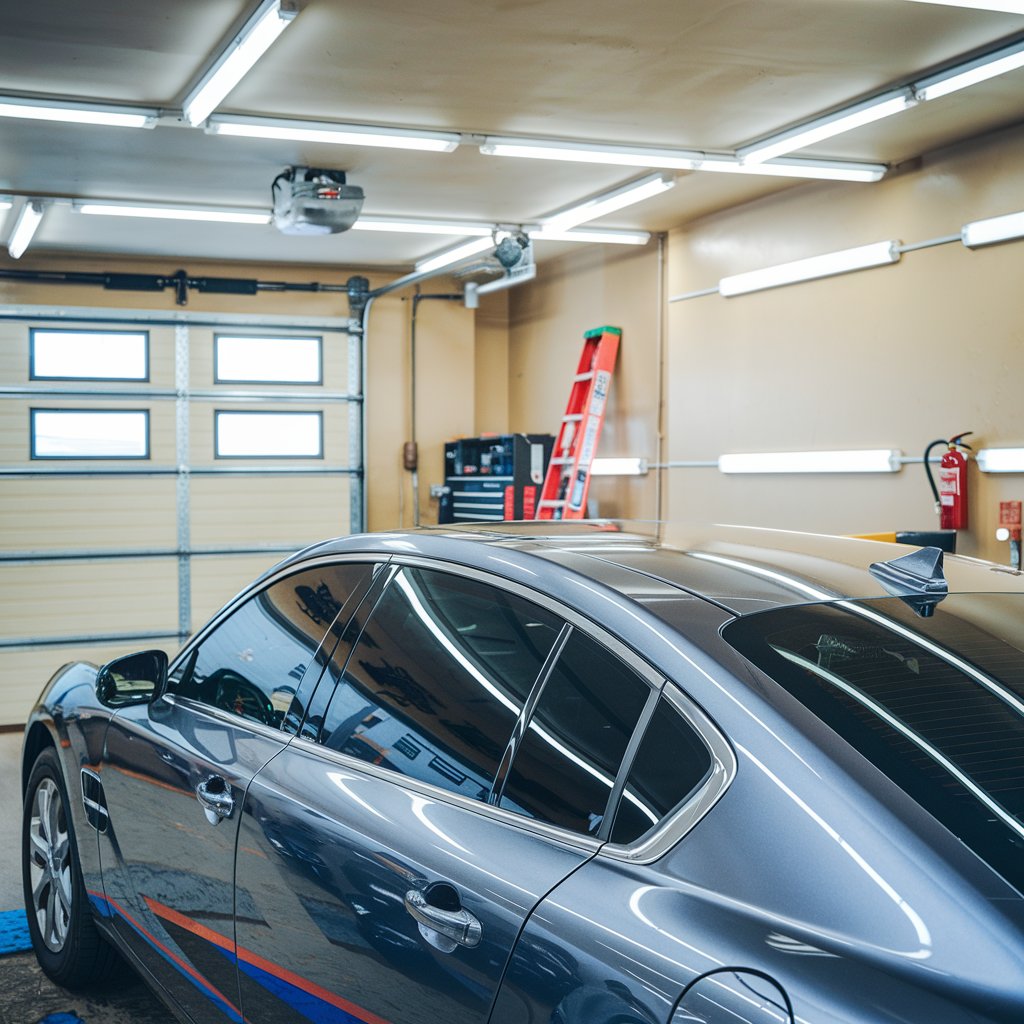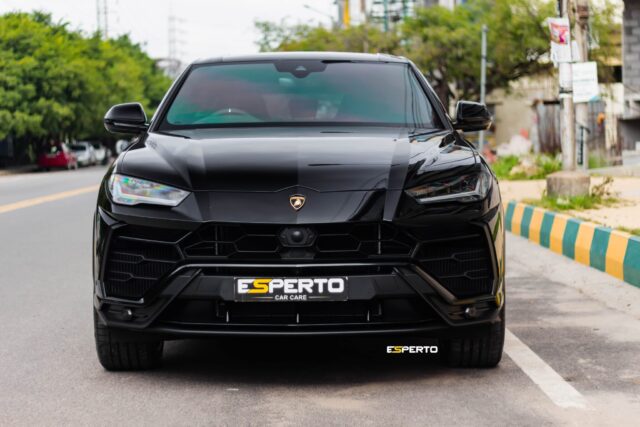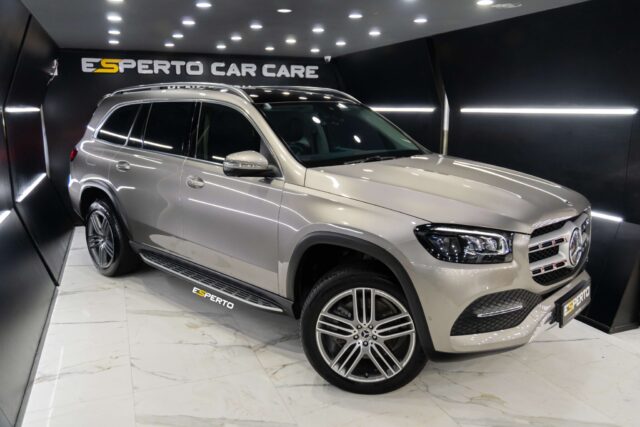Dual-reflective window film greatly enhances car privacy by balancing external reflectivity with interior visibility. Its dual-layered design—with a reflective exterior and a non-reflective interior—creates a one-way mirror effect during daylight. This reduces outside visibility while maintaining clear internal views. The film also minimizes solar heat gain, reduces glare, and provides UV protection. These features make it an effective solution for vehicle discretion, offering advanced comfort and privacy benefits. To improve your vehicle’s protection and style, explore high-quality sun control film options for cars in Coimbatore, a choice that naturally aligns with both performance and privacy needs.
Key Takeaways
- The dual-reflective film offers superior daytime privacy by acting as a one-way mirror, reflecting external light and reducing interior visibility.
- The reflective exterior layer minimizes visibility from the outside, while the non-reflective interior maintains clear views for occupants.
- It enhances privacy in bright conditions, allowing passengers to enjoy unobstructed views while ensuring discretion from onlookers.
- The film provides a sleek, modern aesthetic with tinted windows, further enhancing the vehicle’s privacy and visual appeal.
- Professional installation ensures optimal privacy performance by preventing common issues like air bubbles and ensuring legal compliance.
What Is Dual-Reflective Window Film, and Why Is It Popular for Car Privacy?
Dual-reflective window film is engineered to balance external reflectivity with internal visibility, effectively providing superior daytime privacy for car interiors.
Its ‘dual’ designation emerges from its two-sided design: one side exhibits a more reflective surface to deter prying eyes, while the opposite side guarantees clear visibility from within.
This unique configuration not only enhances privacy but also reduces solar heat gain and glare, making it a preferred choice for automotive applications.
How Does Dual-Reflective Film Provide Daytime Privacy Inside a Car?
This specialized reflective film acts as a one-way film during daylight hours, providing enhanced privacy by limiting outside visibility while preserving a clear view from inside the vehicle.
It achieves this by reflecting more natural light off the external surface, thereby increasing privacy inside the vehicle. The reflective properties of the film guarantee that outsiders see primarily their reflection rather than the car’s interior.
This optical phenomenon is particularly effective in bright conditions, making the dual reflective window film an ideal solution for daytime privacy.
In addition, it efficiently balances privacy with the need for natural illumination, allowing car occupants to enjoy visibility without compromising their seclusion.
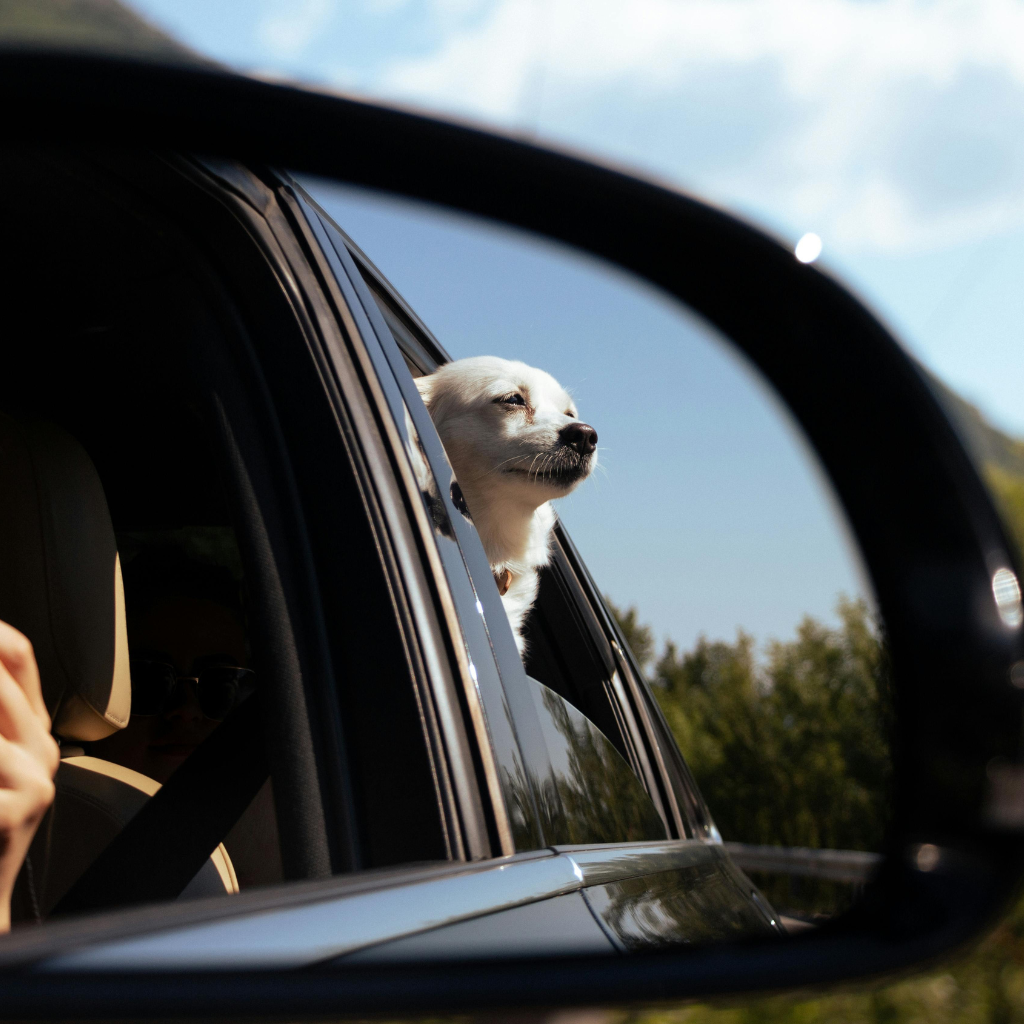
Why Is a Dual Reflective Film Called ‘Dual’—And What Makes It Unique?
What distinguishes dual-reflective window film in the automotive industry lies in its dual-layered construction, which combines an interior non-reflective layer with an exterior reflective layer.
This design enhances privacy by creating a one-way mirror effect, wherein the reflective exterior layer reduces visibility into the vehicle while maintaining clear outward views.
The interior layer, devoid of reflective properties, guarantees unobstructed light transmission and avoids interior mirror effects.
This balance makes dual reflective window film particularly effective for privacy without compromising interior ambience.
The reflective window film’s dual nature allows it to excel in various lighting conditions, adapting to both day and night settings.
Its unique combination of layers and functionality has made it a popular choice for enhancing privacy in vehicles.
How Can Dual Reflective Film Improve Privacy and Comfort in Vehicles?
Dual reflective window film substantially enhances in-vehicle privacy by using a metalized layer that reduces visibility from outside during daytime conditions, effectively functioning as a one-way mirror.
The film’s reflective properties also contribute to thermal comfort by minimizing solar heat gain, thereby reducing the reliance on air conditioning systems.
Additionally, the reduction in glare and enhancement of optical clarity provide visual benefits that improve the driving experience for car owners.
In What Ways Does Dual-Reflective Window Film Increase Privacy Within Your Car?
How does the application of dual-reflective window film enhance vehicular privacy? This specialized film is engineered to maximize privacy by utilizing a unique layering system.
The exterior layer of the reflective window film acts like a mirror, creating a one-way mirror effect that restricts visibility into the car during the daytime. This effect is achieved without compromising the driver’s view of the surroundings.
Additionally, dual reflective window film effectively reduces glare and provides UV protection, safeguarding passengers and interior surfaces from harmful rays.
At nighttime, the film maintains privacy by balancing internal and external light transmission, ensuring clarity for the driver while still minimizing visibility from outside.
This advanced film technology offers an ideal blend of privacy, comfort, and protection for vehicle occupants.
Can Mirror Window Film and Dual-Reflective Film Offer Complete Daytime Privacy?
In evaluating the capabilities of mirror window film and dual-reflective film for providing complete daytime privacy, one must consider the optical properties and technological design inherent in these films.
Mirror window films and dual reflective privacy window films utilize a highly reflective surface, creating a one-way vision effect that makes it difficult to see inside a vehicle during daylight. These films act like a mirror from the outside, enhancing privacy by reflecting light.
When installing privacy window films, achieving effective daytime privacy requires the correct balance of reflectivity and transparency.
However, dual reflective window film at night does not guarantee the same level of privacy due to reduced exterior light, potentially compromising its one-way functionality. Consequently, these films are optimized for daytime applications.
What Are the Visual Benefits of a Reflective Window for Car Owners?
Why do car owners seek out reflective window films for their vehicles? The dual reflective window film offers a myriad of visual benefits that enhance both privacy and aesthetics.
This technology not only provides a reflective mirror window film effect but also reduces glare considerably, allowing more natural light to come into the vehicle. It balances daytime privacy with nighttime visibility, guaranteeing drivers have a clear view after sunset.
- Privacy Enhancement: Guarantees discretion without sacrificing visibility.
- Glare Reduction: Mitigates blinding sunlight and headlight glare.
- UV Protection: Blocks harmful UV rays, safeguarding interiors.
- Heat Rejection: Minimizes heat and glare for increased comfort.
- Aesthetic Appeal: Offers a sleek, modern look through window tinting.
These attributes make dual reflective films an excellent choice for car owners seeking functionality and style.
Does Reflective Window Film Help with Heat Rejection and UV Protection?
Reflective window film is engineered to enhance thermal comfort by effectively rejecting solar heat, a critical factor in hot weather conditions.
By integrating advanced coatings, these films notably attenuate ultraviolet radiation, mitigating UV-induced degradation and protecting vehicle interiors.
Dual-reflective window film further optimizes heat rejection through its specialized construction, offering superior performance compared to standard films and ensuring a balanced transmission of visible light.
Does Reflective Film Help with Heat Rejection in Hot Weather?
How effectively can reflective window film mitigate heat and UV exposure in vehicles? Dual reflective film offers significant heat rejection, which significantly contributes to better energy efficiency and increased comfort within the vehicle. The tint’s reflectivity serves as a barrier against solar heat, ensuring a cooler cabin environment where privacy is needed.
- Heat Rejection: Reduces solar heat gain, keeping the interior cooler.
- UV Rays Protection: Blocks harmful UV rays, safeguarding upholstery and skin.
- Energy Efficiency: Lessens the load on air conditioning systems, saving fuel.
- Tint and Reflectivity: Enhances privacy by reducing glare and adding privacy without compromising visibility.
- Improved Comfort: Maintains a comfortable temperature, contributing to the overall driving experience.
Implementing such films not only adds privacy but also optimizes thermal management.
How Does Window Film and Dual-Reflective Window Film Block UV Rays?
When discussing the efficacy of window films in mitigating UV radiation, it is essential to contemplate the advanced technology behind dual-reflective films.
These films are specifically engineered to block UV rays by being reflective on both sides, thereby providing thorough protection for glass surfaces. The film comes with a unique design that is less metallic, allowing it to maintain visibility while effectively filtering harmful UV radiation.
Installing dual-reflective window film on the exterior surface of a vehicle’s windows greatly enhances UV protection. This sophisticated technology guarantees that over 99% of UV rays are obstructed, safeguarding interiors from sun damage.
The strategic layering of dual-reflective window film contributes to its ability to serve as a formidable barrier against UV exposure, guaranteeing prolonged durability and passenger safety.
What Makes the Heat Rejection Benefit of Dual-Reflective Window Film Superior?
Although various window films offer certain levels of heat rejection, dual-reflective window film stands out due to its advanced thermal insulation properties. This premium product provides outstanding heat rejection, ensuring that the interior remains cool and comfortable.
Key features contributing to its superiority include:
- Shiny metallic surface: Reflects sunlight, reducing heat penetration.
- Dual functionality: Offers privacy without compromising visibility, appearing dark outside while undistorted from inside.
- Efficiency: Minimizes reliance on the air conditioner, leading to lower utility bills.
- Comprehensive protection: Enhances comfort both inside and outside the vehicle.
- Durability: Maintains performance over time, resisting fading and degradation.
These characteristics make dual reflective window film an excellent choice for those seeking ideal heat management and privacy solutions.
Which Type of Tint or Film Is Best for Your Car’s Reflective Needs?
In evaluating the ideal tint or film for automotive reflective needs, one must consider the distinctions between mirror window film and dual-reflective film, as each offers unique light reflectance properties and aesthetic outcomes.
Regular tint, while effective in basic UV filtration, may fall short in providing the enhanced privacy and glare reduction that reflective window films afford.
Additionally, the performance of dual-reflective film varies greatly depending on car window orientation and curvature, necessitating a nuanced approach to selection based on specific vehicular configurations.
Is There a Difference Between Mirror Window Film and Dual-Reflective Film?
How do mirror window film and dual-reflective film differ in functionality and application for automotive privacy? Mirror window film primarily reflects light on both sides, creating a mirrored appearance, but it can compromise visibility. In contrast, dual-reflective window film offers a balanced approach by reflecting sunlight outside while maintaining visibility inside, enhancing privacy without sacrificing interior clarity.
Key distinctions include:
- Dual-reflective film: Superior privacy with clear interior view.
- Mirror window film: Reflects light on both sides, reducing visibility.
- Ceramic dual reflective window film: Advanced technology for improved heat rejection.
- Premium dual reflective window film: Offers enhanced durability and aesthetics.
- Benefit of dual-reflective window film: Ideal for various types of window installations, optimizing privacy and comfort.
Such window films are essential for automotive privacy applications.
Which Is Better for Vehicles: Regular Tint or Reflective Window Film?
Selecting the ideal window film for vehicles involves a thorough understanding of the distinctions between regular tint and reflective window film, particularly for those prioritizing privacy and performance.
Regular tint offers a consistent shade, suitable for expansive windows, but may compromise car privacy at night when indoor lighting is high.
Reflective window film, including dual reflective and mirror window film, excels in providing privacy by making the outside view challenging for people inside to discern. However, reflective films perform best during the day, with reduced effectiveness at night.
Dual reflective window film is specifically designed to balance interior visibility and external reflection, effectively addressing privacy needs. For added functionality, incorporating an anti-fog film for car use can improve visibility in humid or cold conditions, especially on side mirrors or interior glass.
Each type offers unique benefits; thus, the choice hinges on specific reflective needs and usage conditions.
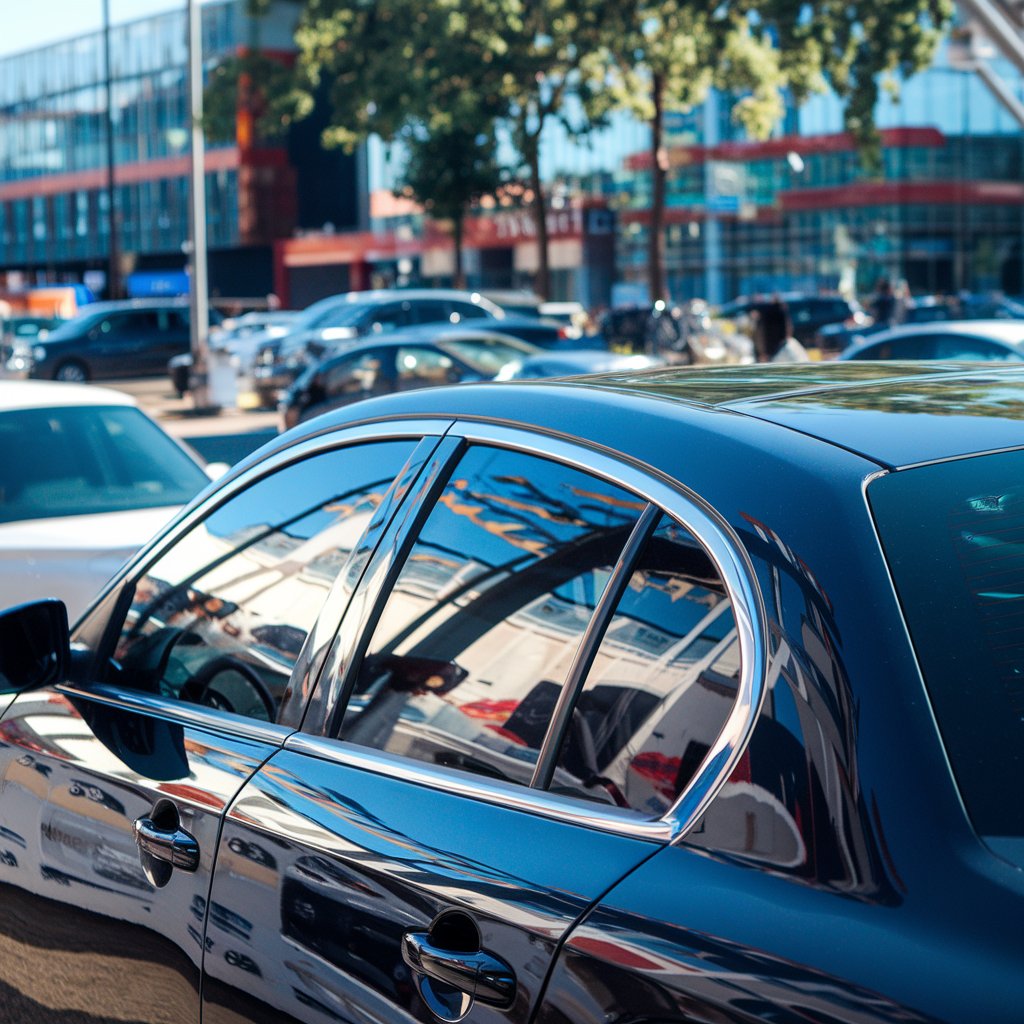
How Does Dual-Reflective Film Perform on Different Car Windows and Angles?
When evaluating the performance of dual-reflective window film on different car windows and angles, one must consider various optical and functional factors.
Dual reflective window film is designed to optimize privacy and glare reduction while maintaining a clear view from inside the car. Its performance varies depending on the curvature and angle of car windows.
- Reflective properties: Enhanced on side windows, less pronounced on rear windows.
- Privacy levels: High on steeper angles, reducing visibility into the vehicle.
- Compatibility: Works well with ceramic coatings; may contrast with mirror window films.
- Current trend: Increasing preference for dual reflective films over traditional tints in the automotive industry.
- Interior clarity: Maintains visibility inside the car, which is vital for driver safety.
These factors are essential in selecting the appropriate window films for specific vehicle needs.
What Should You Know Before Installing Dual-Reflective Window Film in Your Car?
Before installing dual-reflective window film in a vehicle, it is essential to assess the compatibility of the film with different types of automotive glass, as certain films may not adhere properly to windows with specialized coatings or treatments.
The longevity of the film is influenced by factors such as exposure to ultraviolet radiation, environmental conditions, and the quality of the installation process.
Additionally, combining dual-reflective film with existing tints may result in unintended optical effects or reduced visibility, necessitating a careful evaluation of the cumulative visual impact.
Can Reflective Window Film Be Installed on Any Type of Car Window?
Installing reflective window film on car windows involves several technical considerations to confirm peak performance and compliance with regulations.
While dual-reflective window films are often used in cars, window films are highly reflective and provide privacy; not all car windows are suitable for installation.
Key considerations include:
- Window curvature: Excessive curvature may hinder film adhesion.
- Type of glass: Tempered glass is generally more compatible than laminated glass.
- Regulatory compliance: Local laws dictate permissible reflectivity levels.
- Existing tints: Pre-tinted windows can affect film performance.
- Interior furnishing: Dual-reflective films can impact interior luminosity similarly to mirror window film in-car settings.
Understanding these elements confirms that dual-reflective window film effectively enhances privacy without compromising safety or aesthetics.
What Factors Affect the Lifespan of a Dual-Reflective Window Film on Cars?
In addition to the technical considerations of installing dual-reflective window film on car windows, understanding the factors influencing its longevity is vital for ideal performance.
Primarily, the quality of the film itself plays a critical role; premium films often provide enhanced durability due to superior materials and advanced manufacturing processes.
Installation precision is another important factor; improper application can lead to air bubbles and edge peeling, greatly decreasing lifespan.
Exposure to environmental factors, like UV radiation, temperature fluctuations, and humidity levels, can accelerate degradation.
Moreover, the film’s maintenance regime, including regular cleaning with non-abrasive solutions, influences its sustained performance.
Finally, adhesive technology determines the film’s stability, as poor adhesion can lead to premature detachment.
Are There Any Drawbacks to Using Tint and Dual-Reflective Window Film Together?
When contemplating the integration of tint and dual-reflective window film on a vehicle, what potential drawbacks should one consider?
Combining these materials may introduce several challenges, both from an installation and functional perspective. It is crucial to weigh these potential issues before proceeding with the application to guarantee ideal results.
- Adhesion Conflicts: Layering films may lead to inadequate bonding, causing peeling or bubbling.
- Visual Distortion: Multiple layers can result in optical clarity reduction, affecting driver visibility.
- Heat Buildup: Enhanced solar absorption might increase interior temperatures, counteracting cooling benefits.
- Legal Compliance: Over-tinting may violate regulatory standards, leading to potential penalties.
- Cost Implications: Dual application considerably increases material and labour expenses, impacting the overall budget.
Evaluating these factors with a professional installer guarantees informed decision-making.
Conclusion
Dual-reflective window film offers a strategic advantage for enhancing automotive privacy and comfort. Its dual-layer design maximizes interior seclusion by reflecting external views while maintaining internal visibility. The film’s advanced construction also contributes to effective heat rejection and UV protection, safeguarding passengers and interiors from harmful radiation. Selecting the appropriate film variant requires consideration of vehicle-specific reflective needs and legal regulations. Correct installation is key to fully enjoying these benefits, highlighting the value of professional skill in ensuring the best outcome.

